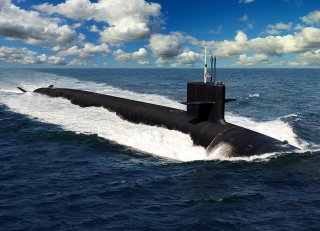The U.S. Navy's New Columbia-Class Submarines: What You Need to Know
The Columbia's will have a longer mission life by virtue of being engineered with a “life-of-core” nuclear reactor, a system which means a boat will not have to return to dock for lengthy refueling.
Here's What You Need to Remember: The new class of submarines, slated to serve well into the 2080s or even beyond, may grow beyond the twelve planned boats, depending upon how various threats evolve.
America’s new nuclear missile submarines will secretly patrol the dark corners of the undersea, quietly tracking enemy movements sustaining a persistent threat of nuclear annihilation against anyone willing to launch a catastrophic first strike on the U.S. homeland.
Assured destruction keeps the peace through the fundamental paradox of nuclear strategic deterrence: a strategy well established as the Pentagon seeking to launch a new fleet of high-tech, heavily-armed ballistic missile submarines tasked with ushering in a new era in nuclear deterrence.
The Navy has awarded a $9.5 billion deal to General Dynamics Electric Boat to build the first two Columbia-class nuclear-armed submarines, a monumental step toward ultimately building as many as twelve new boats to replace the aging Ohio-class.
The first submarine is scheduled for delivery to the Navy in 2027, and the second one in 2029.
The 560-foot boats will be armed with Trident II D5 nuclear missiles, fly-by-wire, computer-generated navigational controls, a stealthy X-shaped stern, and ultra-quieting “electric drive” propulsion. The concept with the Columbia’s is to not only create a submarine that will be upgraded to accommodate new nuclear missiles as they emerge but also to construct the stealthiest submarine ever to exist. After all, remaining “undetected” is the whole point of undersea strategic deterrence, something which could correctly be characterized as an ability to maintain the ability to destroy entire enemy cities, even countries, from undisclosed, unknown locations.
Making the Columbia stealthy is very important since the advent of newer kinds of more sensitive sonar, undersea drones, and laser scanners are increasingly making it much harder for submarines to remain undetected.
The new class of submarines, slated to serve well into the 2080s or even beyond, may grow beyond the twelve planned boats, depending upon how various threats evolve. The Columbia's will have a longer mission life by virtue of being engineered with a “life-of-core” nuclear reactor, a system which means a boat will not have to return to dock for lengthy refueling. This extends mission life, and therefore the operations tempo, of the submarines. The new class will also incorporate some elements of the ultra-high-tech Virginia-class submarines such as a fiber optic cable for periscope viewing and semi-autonomous joystick-type controls to replace the older hydraulic systems.
Many see the need for these new boats as nothing short of urgent, and the Pentagon has for years cited the Columbia-class submarine effort as the Defense Department’s number one acquisition priority, given that the existing Ohio-class boats have served for decades beyond the original intention.
China’s rapid construction and weaponization of its new Jin-class ballistic missile submarines is also, not surprisingly, driving also the effort. The People’s Liberation Army Navy is adding new submarines and also testing a new, even longer-range JL-3 nuclear-armed missiles. The existing JL-2s have a strike range as far as 4,000 miles, enabling Chinese submarines to hold larger areas of the continental United States at risk of a nuclear attack.
Kris Osborn is Defense Editor for the National Interest. Osborn previously served at the Pentagon as a Highly Qualified Expert with the Office of the Assistant Secretary of the Army—Acquisition, Logistics & Technology. Osborn has also worked as an anchor and on-air military specialist at national TV networks. He has appeared as a guest military expert on Fox News, MSNBC, The Military Channel, and The History Channel. He also has a Masters Degree in Comparative Literature from Columbia University.
This article first appeared in 2020 and is being republished due to reader interest.

